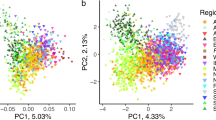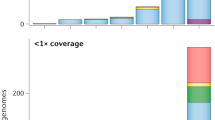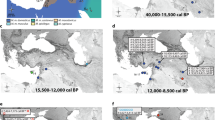Abstract
The cat has long been important to human societies as a pest-control agent, object of symbolic value and companion animal, but little is known about its domestication process and early anthropogenic dispersal. Here we show, using ancient DNA analysis of geographically and temporally widespread archaeological cat remains, that both the Near Eastern and Egyptian populations of Felis silvestris lybica contributed to the gene pool of the domestic cat at different historical times. While the cat’s worldwide conquest began during the Neolithic period in the Near East, its dispersal gained momentum during the Classical period, when the Egyptian cat successfully spread throughout the Old World. The expansion patterns and ranges suggest dispersal along human maritime and terrestrial routes of trade and connectivity. A coat-colour variant was found at high frequency only after the Middle Ages, suggesting that directed breeding of cats occurred later than with most other domesticated animals.
This is a preview of subscription content, access via your institution
Access options
Access Nature and 54 other Nature Portfolio journals
Get Nature+, our best-value online-access subscription
$29.99 / 30 days
cancel any time
Subscribe to this journal
Receive 12 digital issues and online access to articles
$119.00 per year
only $9.92 per issue
Buy this article
- Purchase on Springer Link
- Instant access to full article PDF
Prices may be subject to local taxes which are calculated during checkout


Similar content being viewed by others
References
Engels, D. W. Classical Cats: The Rise and Fall of the Sacred Cat (Routledge, 2001).
Van Neer, W., Linseele, V., Friedman, R. & De Cupere, B. More evidence for cat taming at the Predynastic elite cemetery of Hierakonpolis (Upper Egypt). J. Arch. Sci. 45, 103–111 (2014).
Vigne, J.-D., Guilaine, J., Debue, K., Haye, L. & Gérard, P. Early taming of the cat in Cyprus. Science 304, 259 (2004).
Yamaguchi, N., Kitchener, A. C., Driscoll, C. & Nussberger, B. Felis silvestris. IUCN http://dx.doi.org/10.2305/IUCN.UK.2015-2.RLTS.T60354712A50652361.en (2015).
Driscoll, C. A. et al. The Near Eastern origin of cat domestication. Science 317, 519–523 (2007).
Driscoll, C. A., Macdonald, D. W. & O’Brien, S. J. From wild animals to domestic pets, an evolutionary view of domestication. Proc. Natl Acad. Sci. USA 106, 9971–9978 (2009).
Price, E. O. Animal Domestication and Behavior (CABI Publishing, 2002).
Wozencraft, C. in Mammal Species of the World 3rd edn (eds Wilson, D. E. & Reeder, D. M. ) http://go.nature.com/2p5vsxb (Johns Hopkins Univ. Press, 2005).
Zeder, M. A. in Biodiversity in Agriculture (eds Gepts, P. et al. ) 227–259 (Cambridge Univ. Press, 2012).
Mattucci, F., Oliveira, R., Lyons, L. A., Alves, P. C. & Randi, E. European wildcat populations are subdivided into five main biogeographic groups: consequences of Pleistocene climate changes or recent anthropogenic fragmentation? Ecol. Evol. 6, 3–22 (2015).
Montague, M. J. et al. Comparative analysis of the domestic cat genome reveals genetic signatures underlying feline biology and domestication. Proc. Natl Acad. Sci. USA 111, 17230–17235 (2014).
Axelsson, E. et al. The genomic signature of dog domestication reveals adaptation to a starch-rich diet. Nature 495, 360–364 (2013).
Kaelin, C. B. et al. Specifying and sustaining pigmentation patterns in domestic and wild cats. Science 337, 1536–1541 (2012).
Guimaraes, S. et al. A cost-effective high-throughput metabarcoding approach powerful enough to genotype ~44 000 year-old rodent remains from Northern Africa. Mol. Ecol. Resour. http://dx.doi.org/10.1111/1755-0998.12565 (2016).
Driscoll, C. A., Clutton-Brock, J., Kitchener, A. C. & O’Brien, S. J. The taming of the cat. Genetic and archaeological findings hint that wildcats became housecats earlier—and in a different place—than previously thought. Sci. Am. 300, 68–75 (2009).
Pierpaoli, M. et al. Genetic distinction of wildcat (Felis silvestris) populations in Europe, and hybridization with domestic cats in Hungary. Mol. Ecol. 12, 2585–2598 (2003).
Málek, J. The Cat in Ancient Egypt, revised edn 144 (British Museum Press, 1993–2006).
Spassov, N., Simeonovski, V. & Spiridonov, G. The wild cat (Felis silvestris Schr.) and the feral domestic cat: problems of the morphology, taxonomy, identification of the hybrids and purity of the wild population. Hist. Nat. Bulg. 8, 101–120 (1997).
Kitchener, A. C. & Rees, E. E. Modelling the dynamic biogeography of the wildcat: implications for taxonomy and conservation. J. Zool. 279, 144–155 (2009).
Ivanova, S . et al. Magura Cave, Bulgaria: a multidisciplinary study of Late Pleistocene human palaeoenvironment in the Balkans. Quat. Int. 415, 86–108 (2016).
Dubey, S. et al. Molecular evidence of Pleistocene bidirectional faunal exchange between Europe and the Near East: the case of the bicoloured shrew (Crocidura leucodon, Soricidae). J. Evol. Biol. 20, 1799–1808 (2007).
Faure, E. & Kitchener, A. C. An archaeological and historical review of the relationships between felids and people. Anthrozoos 22, 221–238 (2009).
Peters, J. Römische Tierhaltung und Tierzucht. Eine Synthese aus archäozoologischer Untersuchung und schriftlich-bildlicher Überlieferung 444 (Verlag Marie Leidorf, 1998).
Johansson, F. & Hüster, H. Untersuchungen an Skelettresten von Katzen aus Haithabu (Ausgrabung 1966 – 1969) 86 (Wachholtz, 1987).
Ewing, E. Fur in dress 168 (Batsford, 1981).
Jones, E. P., Eager, H. M., Gabriel, S. I., Johannesdottir, F. & Searle, J. B. Genetic tracking of mice and other bioproxies to infer human history. Trends Genet. 29, 298–308 (2013).
Sidebotham, S. E. Berenike and the Ancient Maritime Spice Route (Univ. California Press, 2011).
Ball, W. Rome in the East: The Transformation of an Empire 523 (Routledge, 2000).
Boivin, N., Crowther, A., Helm, R. & Fuller, D. East Africa and Madagascar in the Indian Ocean world. J. World Prehist. 26, 213–281 (2013).
Witzenberger, K. A. & Hochkirch, A. The genetic integrity of the ex situ population of the European wildcat (Felis silvestris silvestris) is seriously threatened by introgression from domestic cats (Felis silvestris catus). PLoS ONE 9, e106083 (2014).
Girdland Flink, L. et al. Establishing the validity of domestication genes using DNA from ancient chickens. Proc. Natl Acad. Sci. USA 111, 6184–6189 (2014).
Ludwig, A. et al. Coat color variation at the beginning of horse domestication. Science 324, 485 (2009).
Boivin, N. L. et al. Ecological consequences of human niche construction: examining long-term anthropogenic shaping of global species distributions. Proc. Natl Acad. Sci. USA 113, 6388–6396 (2016).
Pruvost, M., Grange, T. & Geigl, E.-M. Minimizing DNA-contamination by using UNG-coupled quantitative real-time PCR (UQPCR) on degraded DNA samples: application to ancient DNA studies. Biotechniques 38, 569–575 (2005).
Champlot, S. et al. An efficient multistrategy DNA decontamination procedure of PCR reagents for hypersensitive PCR applications. PLoS ONE 5, e13042 (2010).
Bennett, E. A. et al. Library construction for ancient genomics: single strand or double strand? Biotechniques 56, 289–300 (2014).
Acknowledgements
This research has been funded by the IAP program (BELSPO), the KU Leuven BOF Centre of Excellence Financing on CAS, and the CNRS (T.G. and E.-M.G.). The high-containment laboratory of the Institut Jacques Monod, Paris was supported by a grant to E.-M.G. from the University Paris Diderot, ARS 2016-2018. The sequencing facility of the Institut Jacques Monod, Paris, and J.D., were supported by grants to T.G. from the University Paris Diderot, the ‘Fondation pour la Recherche Médicale’ (DGE20111123014), and the ‘Région Ile-de-France’ (grant 11015901). C.O. was supported by the FWO mobility program (V4.519.11N, K2.197.14N, K2.057.14N). Faunal research carried out by J.P. and team in Anatolia received funding by the German Research Foundation (DFG PE424/10-1,2). Research by N.Bo. M.E.P., and A.C. was supported by an ERC grant (206148) and UK NERC Radiocarbon Facility grant (NF/2012/2/4). The archaeological and archaeozoological research conducted by A.Bă. and A. Bo. was supported by the Romanian National Authority for Scientific Research, UEFISCDI (PN-II-ID-PCE-2011-3-1015 and PN-II-RU-TE-2014-4-0519). Research at Songo Mnara was directed by S. Wynne-Jones and J. Fleisher with support from the National Science Foundation (BCS1123091) and the Arts and Humanities Research Council (AH/J502716/1). We thank G. Larson and E. A. Bennett for critical reading of the manuscript; the Ufficio Beni Archeologici della Provincia Autonoma di Bolzano for granting access to the archaeological material of Galgenbühel/Dos de la Forca and J. Crezzini for help in sampling; M.-A. Félix, Institut Jacques Monod and École Normale Supérieure, Paris, for granting access to the pyrosequencer; M. Larmuseau and A. Van Geystelen for discussions and assistance with nuclear SNP analyses; K. Knaepen, M. Coomans, and A. Giucca for support in laboratory procedures in Leuven; and J. Nackaerts of the veterinary hospital Kruisbos (Wezemaal, Belgium) for providing cat blood samples. We also thank the curators of the following collections for facilitating access to the material under their care and the permission to take tissue samples: the Royal Museum for Central Africa (Tervuren, Belgium), the Muséum National d’Histoire Naturelle and Musée du Louvre (Paris, France), the British Museum and Natural History Museum (London, UK) and the Bavarian State Collection of Anthropology and Palaeoanatomy (Munich, Germany).
Author information
Authors and Affiliations
Contributions
The project was initiated by W.V.N., E.-M.G., C.O., T.G. and R.D. The ancient DNA study was conceived and designed by T.G., E.-M.G. and C.O. C.O. carried out the molecular laboratory work, with support of S.G. and analysed the data. J.D. generated the aMPlex Torrent data. The archaeological bone samples were provided by W.V.N., B.D.C., J.P., N.S., M.E.P., N.Bo., A.M.-M., A.Bă., C.B., N.Be., A.Bo., H.B., J.C., A.C., L.L., N.M., H.M., V.O., M.O., M.O., O.P., E.M.Q.M., J.S., U.W., and W.V.N. and B.D.C. were responsible for their curation and archaeozoological recording. The authors’ list from A.Ba. to U.W. is in alphabetical order. C.O., E.M.G. and T.G. wrote the paper. W.V.N., B.D.C., J.P., N.S., M.E.P., N.Bo., A.M.-M. contributed to further discussion about the interpretation of the data and the outline of the paper. N.Bo. and M.E.P. revised the English. All the authors gave final approval for publication.
Corresponding authors
Ethics declarations
Competing interests
The authors declare no competing financial interests.
Supplementary information
Supplementary Information
Supplementary Methods; Supplementary References; Supplementary Figures 1–5; Supplementary Tables 1–5
Supplementary Data 1,2
Data 1: List of all the ancient and modern samples analysed in this study. Data 2: List of samples successfully analysed in this study and detailed information about the samples, the dating, the genotyping procedures followed, the mtDNA haplotypes and the polymorphic states of the three nuclear markers investigated.
Supplementary Code
Cat aMPlex Torrent bioinformatic tools. A bash script and accessory fasta and gff files for data analysis of the aMPlex Torrent data.
Rights and permissions
About this article
Cite this article
Ottoni, C., Van Neer, W., De Cupere, B. et al. The palaeogenetics of cat dispersal in the ancient world. Nat Ecol Evol 1, 0139 (2017). https://doi.org/10.1038/s41559-017-0139
Received:
Accepted:
Published:
DOI: https://doi.org/10.1038/s41559-017-0139
This article is cited by
-
How to keep wildcats wild: ancient DNA offers fresh insights
Nature (2023)
-
A global synthesis and assessment of free-ranging domestic cat diet
Nature Communications (2023)
-
A dietary perspective of cat-human interactions in two medieval harbors in Iran and Oman revealed through stable isotope analysis
Scientific Reports (2023)
-
Stable isotopes unveil one millennium of domestic cat paleoecology in Europe
Scientific Reports (2022)
-
A unique Toxoplasma gondii haplotype accompanied the global expansion of cats
Nature Communications (2022)



